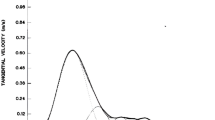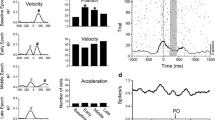Abstract
In this paper, we review single and multijoint studies that, over the years, have provided insight on the cerebellar encoding of limb spatial position. In particular, we present support to the idea that the cerebellum integrates signals from multiple sources to encode global limb parameters. Then, we highlight the result of recent studies that analyzed quantitatively the relationships between limb endpoint position and cerebellar activity. These findings suggest that the cerebellum may share with other central sensorymotor structures an anisotropic representation of limb position characterized by a strong bias along the anteroposterior axis. Finally, we speculate that this anisotropy may also subtend an internal representation of limb mechanics.
Similar content being viewed by others
References
Holmes G. The cerebellum of man. Brain 1939; 62: 1–30.
Eccles JC, Ito M, Szentagothai J. The Cerebellum as a Neuronal Machine. Berlin,: Springer-Verlag, 1967.
Keele SW, Ivry RB. Does the cerebellum provide a common computation of diverse tasks: a timing hypothesis. In: Diamond A. editor. Developmental and neural basis of higher cognitive function. New York,: Annals of the New York Academy of science, 1991: 179–211.
Kawato M. Internal models for motor control and trajectory planning. Curr Opin Neurobiol 1999; 9: 718–727.
Lang CE, Bastian AJ. Cerebellar subjects show impaired adaptation of anticipatory EMG during catching. J Neurophysiol 1999; 82: 2108–2119.
Wolpert DM, Miall RC, Kawato M. Internal models in the cerebellum. Trends Cogn Sci 1998; 9: 338–347.
Schweighofer N, Arbib MA, Kawato M. Role of the cerebellum in reaching movements in humans. I. Distributed inverse dynamics control. Eur J Neurosci 1998; 10: 86–94.
Schweighofer N, Spoelstra J, Arbib MA, Kawato M. Role of the cerebellum in reaching movements in humans. II. A neural model of the intermediate cerebellum. Eur J Neurosci 1998; 10: 95–105.
Nixon PD. The role of the cerebellum in preparing responses to predictable sensory events. Cerebellum 2003; 2: 114–122.
Miall RC, Reckess GZ. The cerebellum and the timing of coordinated eye and hand tracking. Brain Cogn 2002; 48: 212–226.
Kawato M, Kuroda T, Imamizu H, Nakano E, Miyauchi S, Yoshioka T. Internal forward models in the cerebellum: fMRI study on grip force and load force coupling. Prog Brain Res 2003; 142: 171–188.
Blakemore SJ, Frith CD, Wolpert DM. The cerebellum is involved in predicting the sensory consequences of action. Neuroreport 2001; 12: 1879–1884.
Blakemore SJ, Wolpert DM, Frith CD. Central cancellation of selfproduced tickle sensation. Nat Neurosci 1998; 1: 635–640.
Gao JH, Parsons LM, Bower JM, Xiong J, Li J, Fox PT. Cerebellum implicated in sensory acquisition and discrimination rather than motor control. Science 1996; 272: 545–547.
Casabona A, Valle MS, Bosco G, Garifoli A, Lombardo SA, Perciavalle V. Anisotropic representation of forelimb position in the cerebellar cortex and nucleus interpositus of the rat. Brain Res 2003; 972: 127–136.
Ebner TJ. A role for the cerebellum in the control of limb movement velocity. Curr Opin Neurobiol 1998; 8: 762–769.
Valle MS, Bosco G, Poppele RE. Information processing in the spinocerebellar system. Neuroreport 2000; 11: 4075–4079.
Fortier PA, Kalaska JF, Smith AM. Cerebellar neuronal activity related to whole-arm reaching movements in the monkey. J Neurophysiol 1989; 62: 198–211.
Giaquinta G, Valle MS, Caserta C, Casabona A, Bosco G, Perciavalle V. Sensory representation of passive movement kinematics by rat’s spinocerebellar Purkinje cells. Neurosci Lett 2000; 5: 41–44.
Arshavsky YI, Berkinblit MB, Fukson OI, Gelfand IM, Orlovsky GN. Origin of modulation in neurones of the ventral spinocerebellar tract during locomotion. Brain Res 1972; 43: 276–279.
Lundberg A. Function of the ventral spinocerebellar tract. A new hypothesis. Exp Brain Res 1971; 12: 317–330.
Thach WT. Somatosensory receptive fields of single units in cat cerebellar cortex. J Neurophysiol 1967; 30: 675–696.
Shambes GM, Beermann DH, Welker W. Multiple tactile areas in cerebellar cortex: another patchy cutaneous projection to granule cell columns in rats. Brain Res 1978; 157: 123–128.
Rubia FJ, Kolb FP. Responses of cerebellar units to a passive movement in the decerebrate cat. Exp Brain Res 1978; 31: 387–401.
Bauswein E, Kolb FP, Rubia FJ. Cerebellar feedback signals of a passive hand movement in the awake monkey. Pflugers Arch 1984; 402: 292–299.
Kolb FP, Rubia FJ, Bauswein E. Cerebellar unit responses of the mossy fibre system to passive movements in the decerebrate cat. I. Responses to static parameters. Exp Brain Res 1987; 68: 234–248.
van Kan PL, Gibson AR, Houk JC. Movement-related inputs to intermediate cerebellum of the monkey. J Neurophysiol 1993; 69: 74–94.
van Kan PL, Houk JC, Gibson AR. Output organization of intermediate cerebellum of the monkey. J Neurophysiol 1993; 69: 57–73.
Marple-Horvat DE, Stein JF. Cerebellar neuronal activity related to arm movements in trained rhesus monkeys. J Physiol 1987; 394: 351–366.
Thach WT. Discharge of cerebellar neurons related to two maintained postures and two prompt movements. I. Nuclear cell output. J. Neurophysiol 1970; 33: 527–536.
Thach TW. Discharge of cerebellar neurons related to two maintained postures and two prompt movements. II. Purkinje cell output and input. J Neurophysiol 1970; 33: 537–547.
Tarnecki R, Konorski J. Patterned responses of Purkinje cells in cats to passive displacements of limbs, squeezing and touching. Acta Neurobiol Exp 1970; 30: 95–119.
Konorski J, Tarnecki R. Purkinje cells in the cerebellum: their responses to postural stimuli in cats. Proc Natl Acad Sci 1970; 65: 892–897.
Armstrong DM, Cogdell B, Harvey RJ. Firing patterns of Purkinje cells in the cat cerebellum for different maintained positions of the limbs. Brain Res 1973; 50: 452–456.
Bastian AJ. Cerebellar limb ataxia: abnormal control of selfgenerated and external forces. AnnN Y Acad Sci 2002; 978: 16–27.
Goodkin HP, Keating JG, Martin TA, Thach WT. Preserved simple and impaired compound movement after infarction in the territory of the superior cerebellar artery. Can J Neurol Sci 1993; 20 Suppl 3: S93–104.
Fu QG, Flament D, Coltz JD, Ebner TJ. Relationship of cerebellar Purkinje cell simple spike discharge to movement kinematics in the monkey. J Neurophysiol 1997; 78: 478–491.
Fortier PA, Smith AM, Kalaska JF. Comparison of cerebellar and motor cortex activity during reaching: directional tuning and response variability. J Neurophysiol 1993; 69: 1136–1149.
Giaquinta G, Casabona A, Valle MS, Bosco G, Perciavalle V. Spinocerebellar Purkinje cells and rat forelimb postures: a direction-dependent activity. Neurosci Lett 1998; 245: 81–84.
Bosco G, Giaquinta G, Valle MS, Caserta C, Casabona A, Perciavalle V. Distribution of spinocerebellar Purkinje cell responses to passive forelimb movements in the rat. Eur J Neurosci 2000; 12: 4063–4073.
Coltz JD, Johnson MT, Ebner TJ. Cerebellar Purkinje cell simple spike discharge encodes movement velocity in primates during visuomotor arm tracking. J Neurosci 1999; 19: 1782–1803.
Johnson MT, Ebner TJ. Processing of multiple kinematic signals in the cerebellum and motor cortices. Brain Res Rev 2000; 33: 155–168.
Bosco G, Rankin A, Poppele RE. Representation of passive hindlimb postures in cat spinocerebellar activity. J Neurophysiol 1996; 76: 715–726.
Giaquinta G, Casabona A, Valle MS, Bosco G, Perciavalle V. On the relation of rat’s external cuneate activity to global parameters of forelimb posture. Neuroreport 1999; 10: 3075–3080.
Liu X, Robertson E, Miall RC. Neuronal activity related to the visual representation of arm movements in the lateral cerebellar cortex. J Neurophysiol 2003; 89: 1223–1237.
Kettner RE, Schwartz AB, Georgopoulos AP. Primate motor cortex and free arm movements to visual targets in threedimensional space. III. Positional gradients and population coding of movement direction from various movement origins. J Neurosci 1988; 8: 2938–2947.
Bosco G, Poppele RE. Representation of multiple kinematic parameters of the cat hindlimb in spinocerebellar activity. J Neurophysiol 1997; 78: 1421–1432.
Tillery SI, Soechting JF, Ebner TJ. Somatosensory cortical activity in relation to arm posture: nonuniform spatial tuning. J Neurophysiol 1996; 76: 2423–2438.
Prud’homme MJ, Kalaska JF. Proprioceptive activity in primate primary somatosensory cortex during active arm reaching movements. J Neurophysiol 1994; 72: 2280–2301.
Sergio LE, Kalaska JF. Systematic changes in motor cortex cell activity with arm posture during directional isometric force generation. J Neurophysiol 2003; 89: 212–228.
Caminiti R, Johnson PB, Urbano A. Making arm movements within different parts of space: dynamic aspects in the primate motor cortex. J Neurosci 1990; 10: 2039–2058.
Ajemian R, Bullock D, Grossberg S. A model of movement coordinates in the motor cortex: posture-dependent changes in the gain and direction of single cell tuning curves. Cereb Cortex 2001; 11: 1124–1135.
Vindras P, Desmurget M, Prablanc C, Viviani P. Pointing errors reflect biases in the perception of the initial hand position. J Neurophysiol 1998; 79: 3290–3294.
Hwang EJ, Donchin O, Smith MA, Shadmehr R. A gain-field encoding of limb position and velocity in the internal model of arm dynamics. PLoS Biol 2003; 1: 209–220.
Mussa-Ivaldi FA, Hogan N, Bizzi E. Neural, mechanical, and geometric factors subserving arm posture in humans. J Neurosci 1985; 5: 2732–2743.
Flash T, Mussa-Ivaldi F. Human arm stiffness characteristics during the maintenance of posture. Exp Brain Res 1990; 82: 315–326.
Burdet E, Osu R, Franklin DW, Milner TE, Kawato M. The central nervous system stabilizes unstable dynamics by learning optimal impedance. Nature 2001; 414: 446–449.
Flanagan JR, Lolley S. The inertial anisotropy of the arm is accurately predicted during movement planning. J Neurosci 2001; 21: 1361–1369.
McKay WA, Murphy JT. Cerebellar modulation of reflex gain. Prog Neurobiol 1979; 13: 361–417.
Shimansky Y, Wang JJ, Bauer RA, Bracha V, Bloedel JR. On-line compensation for perturbations of a reaching movement is cerebellar dependent: support for the task dependency hypothesis. Exp Brain Res 2004; 155: 156–172.
Yamamoto K, Kobayashi Y, Takemura A, Kawano K, Kawato M. Cerebellar plasticity and the ocular following response. AnnN Y Acad Sci 2002; 978: 439–454.
Lang CE, Bastian AJ. Cerebellar damage impairs automaticity of a recently practiced movement. J Neurophysiol 2002; 87: 1336–1347.
van Beers RJ, Sittig AC, Denier van der Gon JJ. The precision of proprioceptive position sense. Exp Brain Res 1998; 122: 367–377.
Iwaniuk AN, Whishaw IQ. On the origin of skilled forelimb movements. Trends Neurosci 2000; 23: 372–376.
Whishaw IQ. Did a change in sensory control of skilled movements stimulate the evolution of the primate frontal cortex? Behav Brain Res 2003; 146: 31–41.
Graziano MS, Cooke DF, Taylor CS, Moore T. Distribution of hand location in monkeys during spontaneous behavior. Exp Brain Res 2004; 155: 30–36.
Author information
Authors and Affiliations
Corresponding author
Rights and permissions
About this article
Cite this article
Casabona, A., Valle, M.S., Bosco, G. et al. Cerebellar encoding of limb position. Cerebellum 3, 172–177 (2004). https://doi.org/10.1080/14734220410016735
Received:
Accepted:
Issue Date:
DOI: https://doi.org/10.1080/14734220410016735




